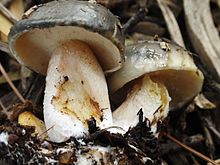| Suillus pungens | |
|---|---|

| |
| Scientific classification | |
| Domain: | Eukaryota |
| Kingdom: | Fungi |
| Division: | Basidiomycota |
| Class: | Agaricomycetes |
| Order: | Boletales |
| Family: | Suillaceae |
| Genus: | Suillus |
| Species: | S. pungens
|
| Binomial name | |
| Suillus pungens | |
| Suillus pungens | |
|---|---|
| Pores on hymenium | |
| Cap is convex | |
| Stipe is bare | |
| Spore print is brown | |
| Ecology is mycorrhizal | |
| Edibility is edible | |
Suillus pungens, commonly known as the pungent slippery jack or the pungent suillus, is a species of fungus in the genus Suillus. The fruit bodies of the fungus have slimy convex caps up to 14 cm (5.5 in) wide. The mushroom is characterized by the very distinct color changes that occur in the cap throughout development. Typically, the young cap is whitish, later becoming grayish-olive to reddish-brown or a mottled combination of these colors. The mushroom has a dotted stem (stipe) up to 7 cm (2.8 in) long, and 2 cm (0.8 in) thick. On the underside on the cap is the spore-bearing tissue consisting of minute vertically arranged tubes that appear as a surface of angular, yellowish pores. The presence of milky droplets on the pore surface of young individuals, especially in humid environments, is a characteristic feature of this species. S. pungens can usually be distinguished from other similar Suillus species by differences in distribution, odor and taste. The mushroom is considered edible, but not highly regarded.
An ectomycorrhizal species, S. pungens forms an intimate mutualistic relationship between its underground mycelium and the young roots of the associated host tree. The fungus—limited in distribution to California—fruits almost exclusively with Monterey and bishop pine, two trees with small and scattered natural ranges concentrated in the West Coast of the United States. Several studies have investigated the role of S. pungens in the coastal Californian forest ecosystem it occupies. Although the species produces more fruit bodies than other competing ectomycorrhizal fungi in the same location, it is not a dominant root colonizer, and occupies only a small percentage of ectomycorrhizal root tips. The fungus's propensity to fruit prolifically despite minimal root colonization is a result of its ability to efficiently transfer nutrients from its host for its own use.